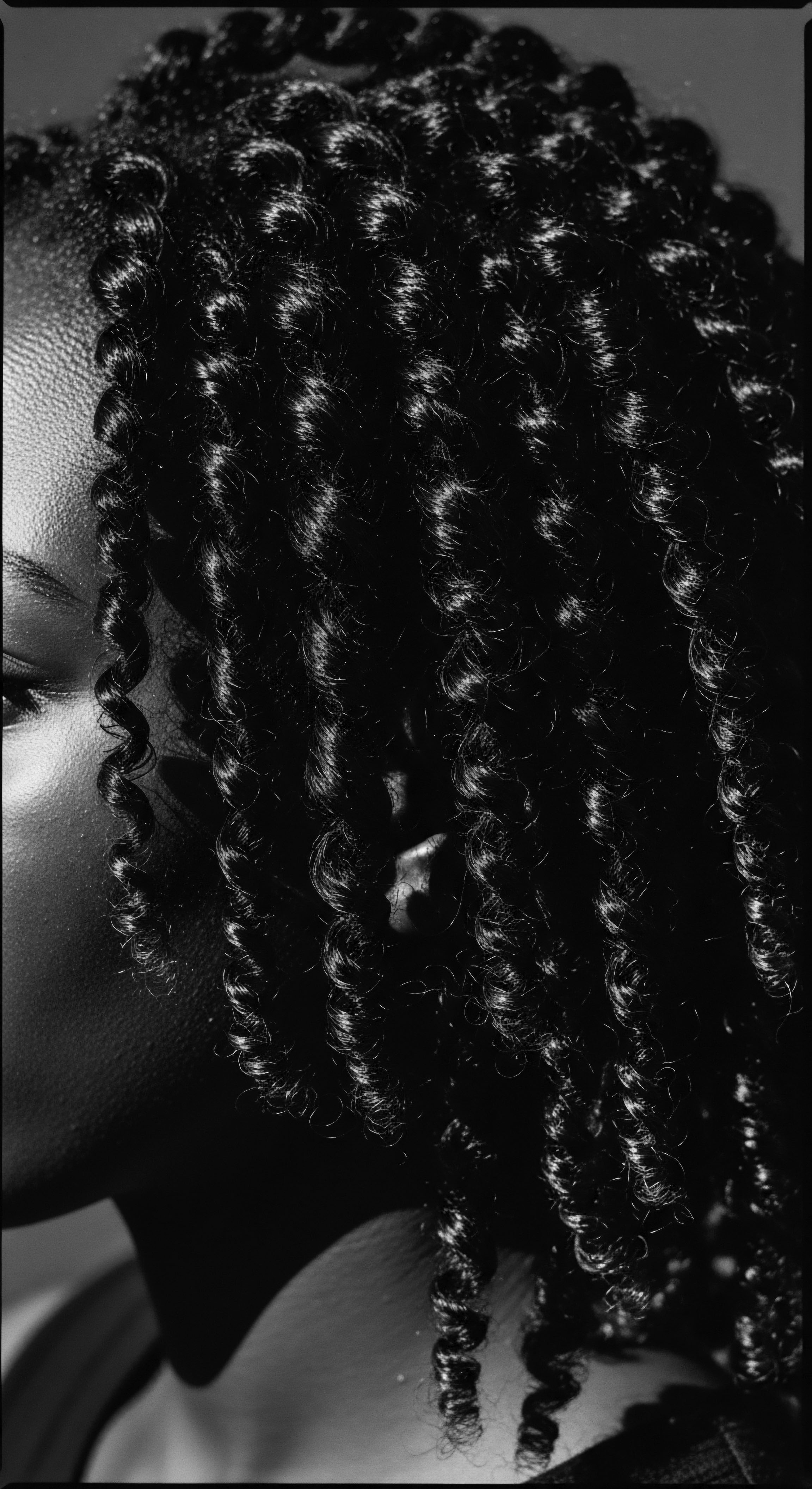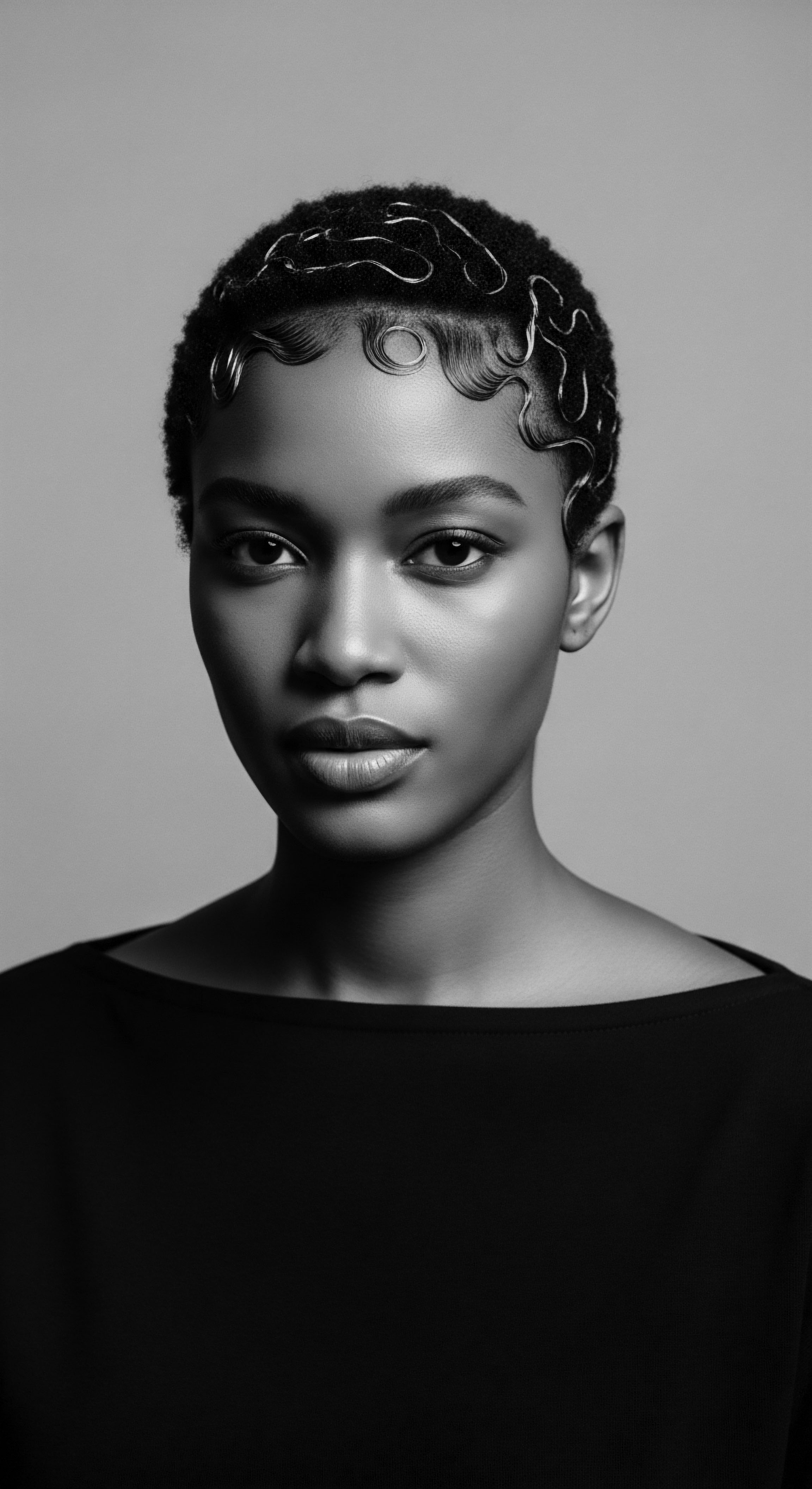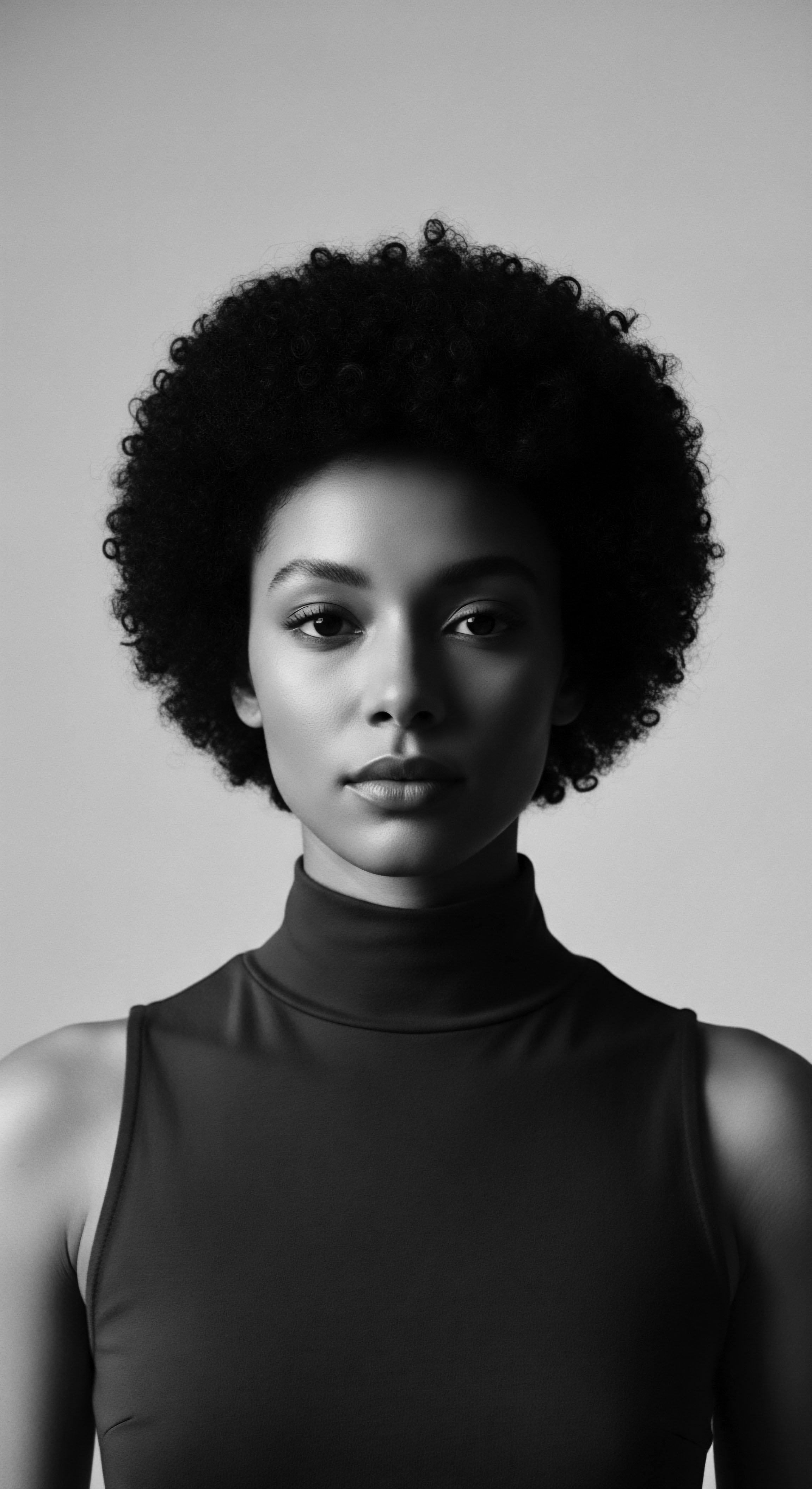
Roots
The very strands of our textured hair carry whispers of ages past, an enduring legacy etched not only in their unique helical structure but also in the nourishment that sustained our ancestors. When we consider whether ancestral dietary habits influenced textured hair’s resilience against the elements, we are not merely asking a question of biology; we are inviting a deep meditation on the heritage of Black and mixed-race peoples. It is a journey into the nutritional wisdom that shaped the very fiber of identity, a story told through the coiled strength and rich color of a legacy. Each curl, each wave, a testament to what came before, a living archive of environmental adaptation and cultural practice.
To truly understand the profound connections, we must first recognize textured hair as a biological marvel. Its distinct morphology – from its elliptical follicle shape to the tight coiling of the hair shaft – naturally lends itself to certain protective qualities. This architecture, however, is not isolated from internal physiological states, which are, in turn, deeply connected to dietary intake.
The building blocks of hair, primarily Keratin, are proteins composed of amino acids, which are directly supplied by the foods we consume. Micronutrients, minerals, and essential fatty acids play equally significant roles in the intricate dance of hair growth, scalp health, and structural integrity.

Hair Anatomy and Ancient Physiology
The intricate anatomy of textured hair, often characterized by its elliptical cross-section and a flatter hair shaft, contributes to its remarkable volume and strength. This structural uniqueness, setting it apart from straighter hair types, also means a natural propensity for dryness due to the difficulty of scalp oils traveling down the coils. Our ancestors, living in diverse climates, understood this implicitly. Their physiological well-being, including the health of their hair, was intrinsically linked to the sustenance they derived from their environment.
The resilience of hair is not simply about its external structure; it is profoundly internal. The hair follicle, a dynamic mini-organ, is among the most metabolically active tissues in the body, second only to intestinal cells. This constant cellular turnover demands a steady and rich supply of nutrients. When these vital resources are scarce, hair is often among the first bodily components to signal distress, manifesting in changes to texture, growth, or even retention.
The very architecture of textured hair, coupled with its profound metabolic demands, made ancestral diets a cornerstone of its vitality and endurance.

Dietary Landscapes of Ancestral Heritage
Across the African continent, prior to colonial disruptions, diets were rich and diverse, reflecting the varied agricultural practices and ecological zones. West African societies, for example, cultivated indigenous cereals such as Millet, Sorghum, and African Rice, alongside staples like Bambara Groundnut and various leafy greens. These diets provided a broad spectrum of complex carbohydrates, plant-based proteins, and vital micronutrients. The centrality of these foods was so deep that enslaved Africans carried seeds and knowledge across the Atlantic, cultivating familiar dietary plants in their gardens of necessity.
The availability of diverse food sources would have naturally provided the necessary elements for robust hair health. Consider the prevalence of essential fatty acids found in nuts, seeds, and certain plant oils indigenous to African regions, such as shea butter and various tree nuts. These lipids play a critical part in maintaining scalp hydration and supporting the integrity of the hair’s outer layer, the cuticle. Similarly, the array of plant-based proteins from legumes and grains would have supplied the amino acids required for keratin synthesis.

Nutrient Deficiencies and Hair’s Vulnerability
The stark reality of nutritional deficiencies becomes tragically apparent when we examine historical shifts in diet, particularly those imposed by forced migration and slavery. The transatlantic slave trade drastically altered the dietary landscapes for millions of Africans, replacing nutrient-dense traditional foods with often monotonous and impoverished rations. This profound change, from varied indigenous fare to a narrow, often calorie-deficient diet of cornmeal and salted pork, had severe physiological consequences. Hair, as a non-essential tissue, bore witness to this deprivation, often exhibiting changes in texture, strength, and even color.
A powerful, albeit tragic, historical example illustrating this connection is the condition known as Kwashiorkor, widely recognized in many parts of Africa where protein and calorie deficiencies prevail. This nutritional syndrome, particularly affecting infants and young children, manifests with noticeable changes in skin and hair, including alterations in hair texture and color—often becoming finer, softer, straighter, and reddish in hue, contrasting with the normal dark shade. While these observed changes were often linked to a lack of essential amino acids like methionine and cysteine in the diet (Bigwood & Robbia, 1955), the hair follicles themselves showed normal structure, pointing to a systemic nutritional lack rather than an intrinsic defect. This historical observation underscores the direct and visible impact of ancestral dietary quality on the hair’s external presentation and internal health.
| Key Nutrient Proteins (Amino Acids) |
| Ancestral Sources and Traditional Beliefs Legumes, grains, lean meats, fish, insects. Valued for overall strength and vitality. |
| Modern Scientific Understanding of Hair Health Building blocks of keratin; deficiency leads to thinning, weakness, or loss. |
| Key Nutrient Iron |
| Ancestral Sources and Traditional Beliefs Dark leafy greens, certain meats, lentils. Associated with blood and life force. |
| Modern Scientific Understanding of Hair Health Essential for oxygen transport to hair follicles; deficiency causes shedding. |
| Key Nutrient Essential Fatty Acids (Omega-3, Omega-6) |
| Ancestral Sources and Traditional Beliefs Nuts, seeds (e.g. shea nuts, palm kernels), fatty fish. Linked to hair sheen and suppleness. |
| Modern Scientific Understanding of Hair Health Maintain scalp health and hair hydration; deficiency can lead to dryness. |
| Key Nutrient Vitamins A, C, E |
| Ancestral Sources and Traditional Beliefs Diverse fruits and vegetables. Recognized for general well-being and skin radiance. |
| Modern Scientific Understanding of Hair Health Antioxidants, support cell growth, collagen production, and scalp health; imbalances affect hair cycles. |
| Key Nutrient Understanding the ancestral reverence for these foods sheds light on their intrinsic role in fostering robust, resilient hair. |
The impact of iron deficiency, for instance, a common concern even today, can lead to increased shedding and stunted hair growth. Historical accounts and studies on nutrient deficiencies often point to such widespread issues. The emphasis on balanced, nutrient-dense diets in many traditional societies was not a mere culinary preference; it was a deeply ingrained practice for collective well-being, extending to the very resilience of hair against environmental pressures and everyday wear.

Ritual
The rhythm of life in ancestral communities was often structured around deliberate practices, many of which touched upon the body’s adornment and care. Textured hair, with its inherent qualities, was not simply a biological feature; it was a canvas for stories, a marker of identity, and a conduit for community. This section delves into how ancestral dietary patterns, directly or indirectly, supported the very foundation upon which these intricate styling rituals and defensive techniques were built. The strength, pliability, and luster of hair, crucial for these elaborate styles that offered protection from the elements, were inseparable from the internal nourishment drawn from the earth’s bounty.

Are Protective Styles Truly Ancient?
The concept of “protective styling” is far from a modern invention. For centuries, across various African cultures, intricate braiding, twisting, and wrapping techniques served multiple purposes ❉ social communication, spiritual connection, and certainly, practical defense against the sun, dust, and arid winds. These styles, such as Cornrows, Locs, and elaborate woven structures, preserved hair length, reduced breakage, and maintained moisture by minimizing direct exposure to harsh environmental factors.
The question then arises ❉ how did diet intersect with the viability of these styles? For hair to be pliable enough for intricate manipulation, strong enough to withstand tension, and resilient enough to retain moisture within the confines of a protective style, its structural integrity is paramount. This integrity is born from internal nutrition.
A protein-rich diet, abundant in amino acids, provides the literal building blocks for the hair’s keratin structure, ensuring its inherent strength and elasticity. Similarly, essential fatty acids contribute to the hair’s natural oils and moisture retention, allowing it to bend without breaking.
- Chebe Powder ❉ Used by the Basara Arab women of Chad, this blend of herbs, including lavender crotons and cherry seeds, is traditionally applied to retain hair length by reducing breakage and enhancing moisture, often mixed with oils. Its efficacy is linked to a healthy hair shaft, itself a product of good internal nourishment.
- Shea Butter ❉ A staple across West Africa, this deeply moisturizing butter, derived from the karite tree, was not just an external application but also connected to a dietary appreciation for plant-based fats. Its rich fatty acid profile mirrors dietary elements that promote hair flexibility.
- African Black Soap ❉ A traditional cleanser made from plantain skins, cocoa pods, and shea butter, it was used to prepare the scalp and hair for styling, ensuring a clean foundation. Its use implicitly points to a holistic approach where cleansing and subsequent nourishment (both internal and external) were entwined.

Traditional Tools and Dietary Connection
The tools used in ancestral hair styling – from meticulously carved wooden combs to bone pins and natural fibers – were as integral as the hands that wielded them. These tools often required a certain degree of hair health to function effectively. Thin, brittle hair, weakened by nutritional deficiencies, would splinter and break under the pressure of even the gentlest comb.
Consider the historical accounts of enslaved African women using substances like Butter or Bacon Fat on their hair as makeshift straightening agents or conditioners, often heated with rudimentary tools like butter knives. This practice, born of desperation and the cruel deprivation of traditional resources, highlights a stark contrast. While these substances provided some temporary lubrication, they lacked the complete nutritional profile of traditional ingredients and certainly could not compensate for systemic dietary deficiencies. The very need for such extreme measures underscored a loss of access to both traditional dietary staples and holistic hair care knowledge.
Ancestral styling practices, intricate and protective, thrived upon a foundation of robust hair vitality, a direct echo of nutrient-rich diets.

The Role of Adornments and Community
Beyond the practical, hair styling was a communal activity, a time for sharing stories, wisdom, and bonding. The adornment of hair with beads, cowries, shells, and threads was not merely decorative; it often signified marital status, age, wealth, or ethnic identity. The ability to hold such adornments, or to sculpt hair into the complex, resilient structures needed to support them, speaks to a certain hair density and strength.
The connection to diet here is subtle yet profound. Flourishing hair, capable of holding complex styles and heavy adornments, is often a visible sign of overall well-being, which in turn is a product of consistent nourishment. When communities faced famine or forced dietary changes, the visual health of hair would inevitably suffer, impacting not only individual appearance but also communal expressions of identity and social standing. The very act of hair preparation itself was a ritual, a tender thread connecting generations, where the wisdom of care, both internal and external, was passed down.

Relay
The narrative of textured hair is one of constant adaptation, resilience, and wisdom passed across generations. This journey of understanding moves from the elemental biology of the strand to the intricate dance of cultural practices, culminating in a recognition of how ancestral dietary habits continue to inform our contemporary appreciation for holistic hair wellness. The relay of this knowledge, from ancient practices to modern insights, compels us to seek deeper connections between what we consume and how our hair responds to the world.

The Interplay of Nutrition and Hair Cycle Defense
Hair growth is a cyclical process, with distinct phases ❉ anagen (growth), catagen (transition), and telogen (rest). The duration and health of the anagen phase, in particular, dictate hair length and density. This cycle is profoundly influenced by systemic nutritional status. Deficiencies in critical nutrients can disrupt this delicate balance, pushing more follicles into the resting or shedding phases prematurely.
For our ancestors, living in environments where consistent and balanced nutrition could not always be guaranteed, their bodies, and by extension their hair, adapted. When nutrient availability was high, hair thrived, perhaps offering a denser canopy against intense sun or greater insulation against cold. When resources were scarce, the body would, by necessity, prioritize vital organ function over hair growth, leading to thinning or loss. This adaptive response, honed over millennia, is an inherited biological legacy.
The very mechanics of how textured hair retains moisture and prevents tangling (its natural coiling) may have been an evolutionary advantage in environments where frequent washing or elaborate external conditioning was not always practical or possible. A healthy, well-nourished internal environment meant hair capable of withstanding environmental stresses with less external intervention.
Consider the impact of zinc, an essential mineral for hair tissue growth and repair. Studies have shown that deficiencies in zinc can lead to hair loss, a condition often reversible with supplementation. Similarly, iron is a critical component for hemoglobin, which carries oxygen to hair follicles.
Iron deficiency, particularly common among women, has been strongly linked to various forms of hair loss, including telogen effluvium, where hair prematurely enters the resting phase. Ancestral diets that were naturally rich in iron sources—such as leafy greens, certain meats, and legumes—would have therefore inadvertently contributed to the physiological resilience and defense mechanisms of textured hair against environmental stressors.
| Historical Period / Context Pre-colonial Africa |
| Dietary Characteristics Diverse, locally sourced, often plant-rich, balanced protein from varied sources (grains, legumes, lean meats, fish). |
| Impact on Hair Resilience and Defense Provided consistent nutrients for robust hair growth, supporting natural protective structures and reducing susceptibility to environmental damage. Hair density and strength were likely maximized. |
| Historical Period / Context Transatlantic Slave Trade / Plantation Era |
| Dietary Characteristics Severely restricted, monotonous, calorie-deficient, lacking micronutrients and varied proteins (e.g. cornmeal, salted pork). |
| Impact on Hair Resilience and Defense Compromised hair health, leading to thinning, brittleness, and changes in texture and color (e.g. Kwashiorkor). Hair's defense against elements would have been significantly weakened. |
| Historical Period / Context Post-Emancipation to Mid-20th Century |
| Dietary Characteristics Limited access to fresh, whole foods due to systemic inequities; reliance on processed or cheaper options. |
| Impact on Hair Resilience and Defense Continued nutritional challenges contributed to hair fragility and increased reliance on damaging chemical or heat treatments to achieve desired aesthetics. |
| Historical Period / Context Contemporary Era (Modern Western Diets) |
| Dietary Characteristics Often characterized by high sugar, processed foods, and unhealthy fats; potential for micronutrient gaps despite caloric abundance. |
| Impact on Hair Resilience and Defense Hair health can still be compromised by dietary imbalances, even in the absence of overt deficiency, highlighting the enduring connection to internal nourishment. |
| Historical Period / Context The journey of textured hair through time reveals a persistent truth ❉ its defense against external forces is intimately tied to internal nourishment. |

Connecting Ancient Wellness to Modern Hair Science
Modern trichology and nutritional science now provide validation for what ancestral wisdom intuitively understood. The link between gut health and overall well-being, including hair health, is increasingly recognized. An imbalanced gut microbiome can impair nutrient absorption, directly impacting the availability of vitamins and minerals crucial for hair growth. Many traditional diets emphasized fermented foods and diverse plant matter, naturally fostering a healthy gut environment long before scientific understanding of microbiomes.
Could ancestral dietary habits have primed textured hair to better resist environmental elements like UV radiation or humidity fluctuations? While definitive direct evidence is complex to isolate solely to diet, a body that is well-nourished, replete with antioxidants (from fruits, vegetables, and traditional herbs), is better equipped to mitigate oxidative stress caused by environmental aggressors. These antioxidants protect cellular structures, including those in hair follicles, from damage. The vibrant, colorful palette of traditional African diets, rich in deeply pigmented fruits and vegetables, would have supplied a robust intake of these protective compounds.
The enduring wisdom of ancestral diets, with their emphasis on diverse, nutrient-rich provisions, offers a profound framework for understanding hair’s innate capacity for self-defense.

Dietary Evolution and Hair’s Ongoing Heritage
The dietary choices of our forebears, shaped by geographical realities and cultural practices, laid a foundational blueprint for textured hair’s inherent capabilities. This understanding prompts us to look beyond topical applications for hair defense, to consider the deeper, systemic roots of hair vitality. The legacy of ancestral eating patterns, characterized by a symbiotic relationship with nature’s provisions, speaks to an enduring truth ❉ true hair resilience emanates from within. This realization forms a profound connection to the ongoing Heritage of textured hair, inspiring us to revisit and honor these ancient ways for contemporary wellness.
- Probiotics ❉ Found in traditionally fermented foods, these beneficial bacteria promote gut health, enhancing nutrient absorption critical for hair vitality.
- Beta-Carotene ❉ Abundant in sweet potatoes and other orange/yellow vegetables, a precursor to Vitamin A, vital for scalp health and preventing hair loss.
- Sulphur-Containing Amino Acids ❉ Essential for keratin synthesis, found in proteins from varied sources, their deficiency historically linked to hair changes (as in Kwashiorkor).

Reflection
The journey through the intricate relationship between ancestral dietary habits and textured hair’s resilience has been a profound one, indeed. It has led us through the very anatomy of the strand, illuminated by the echoes of ancient ways, and then into the rituals that shaped communal life and individual identity. We have witnessed how the very sustenance drawn from the earth became the invisible architecture of a hair’s enduring strength, its defense against a world of elements. This is a story that refuses simplification.
It is not merely about what was eaten, but about the wisdom embedded in those choices, a wisdom that reverberates through generations. Each coil, each strand, a living testament to a continuous, unbroken line of memory, of adaptation, and of beauty. The Soul of a Strand, truly, is a reflection of the nourishment it has received, from the soil to the soul, from the roots of the earth to the heritage woven into every single hair. It is a timeless reminder that our textured hair is a vibrant, living archive, forever connected to the wellspring of our past, a source of enduring strength and pride.

References
- Bigwood, E. J. & Robbia, E. (1955). The amino acid composition of the hair in cases of kwashiorkor. Journal of the Society of Cosmetic Chemists, 6 (4), 48.
- Carney, J. A. (2001). Black rice ❉ The African origins of rice cultivation in the Americas. Harvard University Press.
- Dancer, T. (1801). The medical assistant; or Jamaica practice of physic ❉ designed chiefly for the use of families and plantations. Alexander Aikman.
- Eltis, D. & Richardson, D. (2008). Atlas of the transatlantic slave trade. Yale University Press.
- Jordan, W. D. (1969). White over black ❉ American attitudes toward the Negro, 1550-1812. University of North Carolina Press.
- Lugard, F. D. (1965). The dual mandate in British Tropical Africa. Archon Books.
- Oguntona, S. A. & Oguntona, O. A. (2000). The traditional African diet. Food and Nutrition Bulletin, 21 (2), 220-224.
- Rushton, D. H. (2009). Iron Status in Diffuse Telogen Hair Loss among Women. Acta Dermatovenerologica Croatica, 17 (4), 279-282.
- Sinclair, R. D. (2007). Hair loss ❉ The role of nutrition and diet. Clinics in Dermatology, 25 (2), 173-178.
- Trost, L. B. Whiting, R. H. & Olsen, E. A. (2006). The diagnosis and treatment of iron deficiency and its potential relationship to hair loss. Journal of the American Academy of Dermatology, 54 (5), 824-844.
